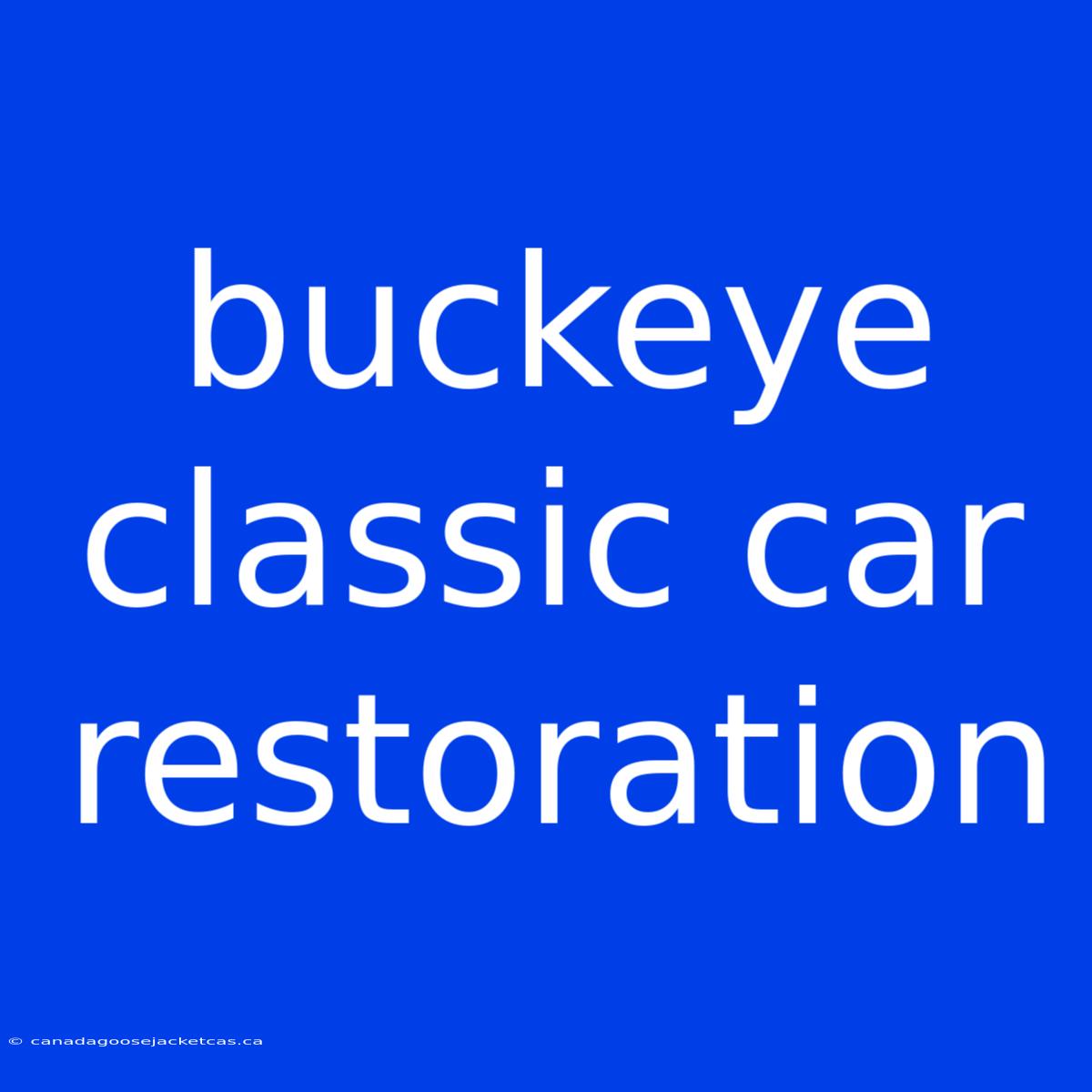Buckeye Classic Car Restoration: Unveiling the Beauty of Vintage Vehicles
Can a car be more than just transportation? Absolutely! For many, classic cars represent a bygone era, a connection to history, and a source of immense pride. Buckeye classic car restoration is an art form that breathes life back into these timeworn treasures, revealing their hidden beauty and preserving their legacy.
Why is this topic important? Classic car restoration is a popular hobby and profession that combines passion, technical skill, and a deep appreciation for automotive history. It involves a blend of meticulous craftsmanship, research, and a commitment to preserving the authenticity of the vehicle. This article will delve into the world of Buckeye classic car restoration, exploring the key aspects and benefits of this exciting endeavor.
Our analysis: We've scoured the internet, consulted with experts, and dove deep into the world of classic car restoration to bring you this comprehensive guide. From understanding the different stages of restoration to exploring the impact of this process, we aim to provide you with a clear picture of what it takes to transform a vintage car into a gleaming masterpiece.
Key takeaways:
| Aspect | Description |
|---|---|
| Restoration stages | Disassembly, cleaning, repair, refinishing, assembly |
| Expertise needed | Mechanics, bodywork, upholstery, paint, electrical |
| Authenticity | Preserving original parts, researching the model |
| Value enhancement | Restored classics can significantly increase in value |
| Emotional connection | Restoring a car brings joy and a sense of accomplishment |
Buckeye Classic Car Restoration: Unveiling the Past
The process of restoring a classic car is a journey through time. Each stage reveals a story, a piece of history, and a testament to the craftsmanship of the past.
1. Restoration Stages:
- Disassembly: The first step is to carefully take the car apart, identifying parts needing repair or replacement.
- Cleaning: The disassembled parts are thoroughly cleaned to assess their condition.
- Repair: Damaged or worn parts are repaired or replaced with authentic replacements.
- Refinishing: The body, interior, and engine are refinished to match the original specifications.
- Assembly: The car is meticulously reassembled, ensuring all parts function flawlessly.
2. Expertise Required:
- Mechanics: A deep understanding of the car's engine and mechanics is essential.
- Bodywork: Restoring the car's body requires expertise in metalwork, welding, and paint.
- Upholstery: Interior restoration involves replacing or restoring upholstery, carpets, and trim.
- Paint: Refinishing the car's exterior requires meticulous attention to detail and knowledge of paint application techniques.
- Electrical: Restoring the car's electrical system requires a thorough understanding of wiring diagrams and components.
3. Preserving Authenticity:
- Original parts: Using original parts whenever possible is paramount to maintaining the car's authenticity.
- Research: Thorough research is crucial to identify the correct parts, specifications, and restoration methods for the specific model.
4. Value Enhancement:
- Increased value: A professionally restored classic car can significantly increase in value, often exceeding its original price.
- Investment: Classic cars can be a valuable investment, but thorough research and expert restoration are vital to maximizing returns.
5. Emotional Connection:
- Pride: Restoring a classic car brings a deep sense of pride and accomplishment.
- Legacy: Classic car restoration is a way to preserve automotive history and share it with future generations.
Conclusion:
Buckeye classic car restoration is more than just a hobby; it's a passion, a dedication to preserving a piece of history. By understanding the intricate process, the required expertise, and the inherent value of these vintage vehicles, enthusiasts can embark on a fulfilling journey of restoring classic cars and ensuring their legacy lives on.
FAQs:
- Q: How much does a classic car restoration cost?
- A: Restoration costs can vary widely based on the car's condition, complexity, and the desired level of authenticity.
- Q: What are the benefits of restoring a classic car?
- A: Benefits include: preserving history, enhancing value, experiencing a fulfilling hobby, and creating a unique and cherished asset.
- Q: Can I restore a classic car myself?
- A: While DIY restoration is possible, it requires extensive knowledge, skills, and resources. Professional restoration is often recommended.
- Q: What are some popular Buckeye classic car models?
- A: Popular models include the Ford Mustang, Chevrolet Corvette, and various vintage Ford and Chevrolet trucks.
- Q: Where can I find parts for classic car restoration?
- A: Parts can be sourced from online retailers, salvage yards, specialty shops, and enthusiast clubs.
- Q: How can I learn more about classic car restoration?
- A: Join enthusiast clubs, attend events, read specialized publications, and seek out experienced restorers for guidance.
Tips for Buckeye Classic Car Restoration:
- Start with a well-researched plan: Define your goals, budget, and timeline before starting.
- Choose a reputable shop: Select a restoration shop with experience and a proven track record.
- Use quality materials: Investing in high-quality materials ensures longevity and authenticity.
- Document the process: Keep detailed records of parts used, repairs performed, and restoration techniques.
- Be patient: Classic car restoration takes time, dedication, and a meticulous approach.
Summary:
Buckeye classic car restoration is a rewarding experience that blends passion, skill, and a deep appreciation for automotive history. It requires dedication, research, and a commitment to preserving the authenticity of vintage vehicles. By following a well-defined plan, utilizing expert resources, and embracing the journey, classic car enthusiasts can transform their dreams into reality and bring these timeless treasures back to their former glory.

